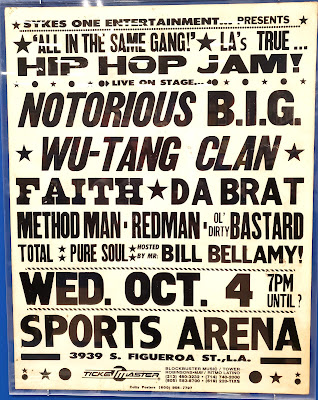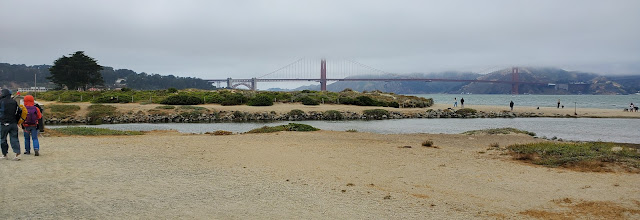 |
| The Bay Bridge and downtown San Francisco as seen from Alcatraz, the former island prison in San Francisco Bay. |
Four nights in late July were enough to give Jane and me a taste of San Francisco. After a short Alaska Air flight from our home in San Diego, we visited Alcatraz, the Presidio, Fishermans Wharf, and more. We ate very well, including at two of the city's best known oyster bars. We rode a cable car. We had mostly sunny weather and we had a good time.
Jane visited San Francisco on business trips several times when she was working in New York. I had been only once before, on a 2004 vacation from New York that included Yosemite National Park and the wine country north of San Francisco.
That trip provided my first look at the kind of sidewalk encampments that are now seen in big cities in much of the world. Sure, I had seen unhoused people sleeping on steam grates in Midtown Manhattan, but not in blocks-long trash-strewn communities. On that trip we rode the same cable car route and we tried one of the oyster bars that we revisited this time, but I left San Francisco that time with a very negative impression. On this trip, the Lyft ride from the airport to our hotel, the Beacon Grand, took us past a few isolated encampments, but the overall impression was of a surprisingly clean and functioning and prosperous city.
There are still post-pandemic empty storefronts here and there, and I have no idea what the office occupancy rate is, but downtown streets, even in the Financial District, have busy sidewalks and lively restaurants and other eateries. The San Francisco Museum of Modern Art, which is in the Financial District, would be an asset to any city. We rode a cable car to and from Fishermans Wharf our first evening in town, we took a Lyft to the Presidio and a free shuttle bus back to downtown, but otherwise we were on foot in this amazingly hilly city.
We had several memorable meals, including oysters on half-shell and cioppino at Scoma's, a seafood restaurant which is much, much better than its location in the touristy Fishermans Wharf area might lead you to expect. Get a table in the bar, where the view is better than from the dining room. More oysters were eaten at Hog Island Oyster Company in the Ferry Building. We were shut out in 2022 when we tried to visit Hog Island's Tomales Bay location in Marshall, California, but we got seated twice here, enjoying Tomales Bay oysters as well as oysters from Puget Sound in Washington. The "steamers" on the menu, by the way, are Manilla clams, not the meaty steamed clams of New England, but served in a sausage-fortified broth, they make a decent dish.
Our other oyster destination was Swan Oyster Depot, which we visited on that 2004 trip. It's far from the tourist parts of town but probably still draws many out-of-towners such as ourselves. There is a Swan's web site (which said it's open to 5:30), but a sign in the restaurant warns that it does not have a web site. When we arrived in San Francisco on Tuesday, July 23, a quick check on Google Maps on my phone showed that Swan was a half-hour walk from our hotel and was open to 5:30. We made the walk and arrived at 3pm expecting a late lunch only to find the place closing. It stopped serving at 2:30. All the seating at Swan is at one counter, so hungry diners line up on the sidewalk and wait for people to leave. We got there around 12:30 on Thursday, July 25, and waited about an hour. We shared a dozen oysters on half-shell, smoked trout and smoked salmon. I thought it was all excellent, but Jane preferred the smaller and saltier oysters we had at Hog Island.
We veered away from oysters one night for a dinner at Fang, an innovative Chinese place in the Financial District, between Union Square and the Ferry Building. We shared steamed buns with duck (delicious), crispy short ribs with bok choy, and sizzling fried rice with clams.
Also on the food front, here are shout outs to Lori's Diner and Sears Fine Foods, both steps from the Beacon's front door. When we couldn't get that lunch at Swan, we backtracked and had a very late and light lunch (BLT and a salad) at Lori's. We had breakfast four mornings at Sears, which even when crowded seems to find tables for everyone and still give prompt service. Jane said her eggs there were perfectly perfect. I could say the same of the pancakes.
Whatever you've heard about San Francisco falling into decline, we saw no evidence of it. If anyone can make the rest of America like San Francisco, I'd say go for it.
Here are some photos:
 |
| Maiden Lane is two blocks of high-end retail starting on the east side of Union Square. |
.jpg) |
| There's a cable car stop right in front of the Beacon Grand. |
 |
| If you're going to San Francisco, the advice used to be, be sure to wear some flowers in your hair. During our visit, plastic flowers adorned many buildings and even this cable car |
 |
| The lobby of the San Francisco Museum of Modern Art. |
 | |
|
 |
| Bruce Nauman's 1983 work, "Life Death / Knows, Doesn't Know." The various messages flash at different times. |
 |
| A special exhibition called The Art of Noise celebrated album covers and concert posters from the 1950s to the 1980s. This Grateful Dead poster is from 1966. |
 |
| The East Coast isn't forgotten. This New York poster for a James Brown concert is also 1966. A show for the entire family! Bring your dancing toddlers! |
 |
| West Coast rap gets a little respect with this circa 1984 poster. |
 |
| The wall of sound becomes visible at SF MoMA. |
 |
| The San Francisco skyline as seen from gardens near the Presidio's Visitor Center. The Presidio was a huge military base that has been turned into a national park. |
 |
| The Tunnel Tops is 14 acres of spaces and trails built atop tunnels carrying U.S. 101 traffic to and from the Golden Gate Bridge, which can be seen from here. |
 |
| It's a little hard to see in this photo, but there's a great playground made up entirely of cypress logs at Tunnel Tops. The pool in the distance is Crissy Marsh, and beyond it is San Francisco Bay. |
 |
| The Golden Gate Bridge as seen from East Beach at the Presidio. It was in the low 60s (about 17C) and very windy during our late July visit. Hardly beach weather. |
 |
| Alcatraz as seen from an arriving ferry. The highest building is the cellblock. |
 |
| Inside the cellblock. |
 |
| Isolation was supposedly rarely used at Alcatraz, but there are still several isolation cells. You can use your fingers to enlarge to photo and make the type more legible. |
 |
| All the cells we saw were single-inmate cells. |
 |
| Three of the hundreds of inmates who passed through Alcatraz. Stroud's life there was the basis of the movie "Birdman of Alcatraz." |
 |
| The Golden Gate Bridge, a symbol of opportunity, and a bird, a metaphor for freedom, as seen from Alcatraz. |
 |
| A 1959 Edsel at Lori's Diner, across the intersection of Powell and Sutter streets from our hotel. |
.jpg) |
| Sears is across Powell Street from the Beacon Grand, our hotel on this trip. Really good spot for breakfast and probably other meals as well. |
 |
| Fang offers its own interpretations of Chinese cuisine in a multi-level space in the Financial District. |
 |
| Swan Oyster Depot is about a half-hour walk west of Union Square, in a neighborhood with Moroccan, Thai, Himalayan and many other types of ethnic food. |
 |
| It doesn't take a lot of people to make Swan seem crowded. |
 |
| Just because something is in Swan's menu doesn't mean it's available. There was no smoked white fish on the day we were there. |








No comments:
Post a Comment